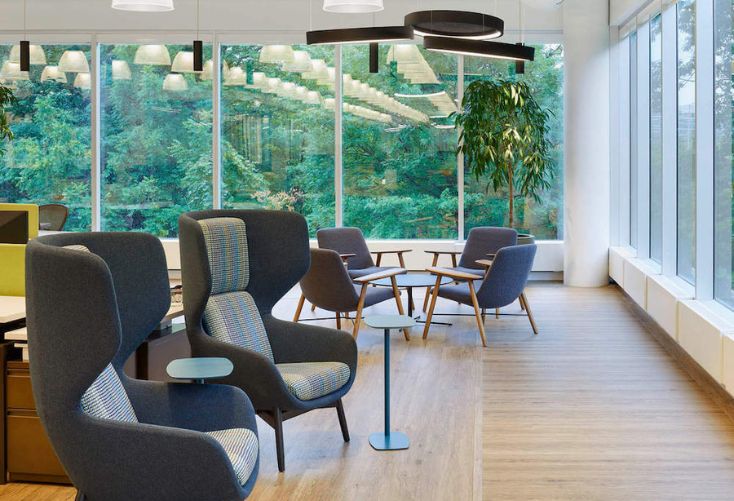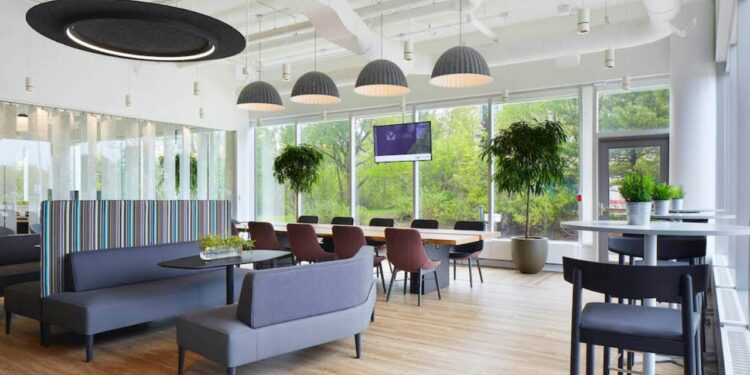- Generation Z has entered the workforce, but attracting young workers to the office, along with other age groups, will take considered design moves that still feel familiar to older generations.
- The challenge is to create workspaces that are both attractive and efficient for all — and if the pandemic taught us one thing, it’s that workspaces need to be agile, adaptable and flexible.
- Here’s how office design can play a very important role in attracting – and retaining – these up-and-comers, according to Inger Bartlett of Barlett & Associates.
This article was written by Inger Bartlett, and was originally published on Work Design Magazine.
Generation Z has entered the workforce. Recognized as the most populous, diverse and tech-savvy of all generations yet, zoomers, as they are colloquially referred to, are poised to have a major impact on how and where work is done.
Recent studies have shown that they are a discerning bunch when it comes to their burgeoning careers, placing greater emphasis on aspects like a company’s ethics and social impact over merely the quality of the product or service it develops. While it’s up to the businesses themselves to communicate and deliver on these values, an office’s design can play a very important role in attracting – and retaining – these up-and-comers.
“…Zoomers who never spend a day in the physical office are missing out on the benefits that personal contacts promote…”
For many of us in older generations, working from home (WFH) is a relatively new concept brought on by the global pandemic restrictions. For zoomers, it’s all they’ve really known. And WFH certainly has its perks – no lengthy and costly commutes, more relaxed and casual settings and a better work-life balance, to name a few. But we are social creatures at heart and zoomers who never spend a day in the physical office are missing out on the benefits that personal contacts promote: the creation of mentor-mentee relationships, to learn skills from more experienced coworkers (and to share their own unique knowledge) and, perhaps most importantly, to be recognized by superiors. If your days are spent at home plugging away at the kitchen table you miss the opportunity to be seen and personally acknowledged for your work.
The challenge now is how to create office spaces that are both attractive and efficient for all. If the pandemic taught us one thing, it’s that workspaces need to be agile, adaptable and flexible – key words we at Bartlett & Associates have actually bantered about when it comes to office design for years but that have certainly taken on greater importance in recent times.

So, how can design help convince zoomers (and everyone else) that the office is the place to be – at least some of the time? First by recognizing that different people have different working styles, different needs and wants, and that simply trying to shoehorn everyone into a one-note space is no longer the right approach (really, was it ever?). Modern-day offices need to support all manners of work, from solo heads-down and group focus sessions to spirited collaborations and formal board meetings. If zoomers see that there are multiple places for them to set down for the day, they will be more likely to feel appreciated and accepted.
“Modern-day offices need to support all manners of work…”
Having grown up with unparalleled access to the internet and personal mobile devices, Gen Z has a practically innate understanding of the digital world and it will go a long way to consider activating spaces with technology that allows for remote communications – let’s face it, Zoom meetings are here to stay and having accessible screens in boardrooms, breakout zones and other areas will make it easy for those in the office to link up with those working remotely. Pocket spaces that accommodate a single user and mini meeting rooms for a small group should also be connected so zoomers know that they’ll be as plugged in at the office as they are at home.

It’s also important to remember that Gen Z is hyper-aware of their mental health and well-being so planning spaces that contribute to a sense of relaxation and decompression, using what we like to call intuitive cues, is something that should not be overlooked. Nature can play a big part in calming the mind and alleviating stress. Bringing in green walls (which also provide an acoustic solution), organic materials like wood, ample access to sunlight, nature-inspired artwork and live greenery can create moments of serenity and peace that all employees will appreciate and benefit from.
Ultimately, the ideal workspace for Gen Z is one that cultivates a community atmosphere while being nimble, digitally accessible and less formally structured than what was the previous convention. Spaces need to be accommodating for those who decide to come in for a few hours a week but also for those who prefer to clock in full time. At the end of the day, design drives behaviour and designing a space that fosters positivity and personal connection is a benefit to everyone, no matter what generation they represent.

 Dr. Gleb Tsipursky – The Office Whisperer
Dr. Gleb Tsipursky – The Office Whisperer Nirit Cohen – WorkFutures
Nirit Cohen – WorkFutures Angela Howard – Culture Expert
Angela Howard – Culture Expert Drew Jones – Design & Innovation
Drew Jones – Design & Innovation Jonathan Price – CRE & Flex Expert
Jonathan Price – CRE & Flex Expert












